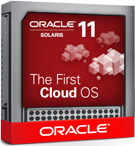Tour d’horizon du processeur SPARC M7
Oracle a récemment dévoilé à l'OpenWorld 2015 son nouveau processeur SPARC M7. Il s'agit du 6ème que l'entreprise a sorti depuis le rachat de Sun Microsystem en 2010. Avec le SPARC M7, Oracle a repoussé les limite des capacités des systèmes SPARC.
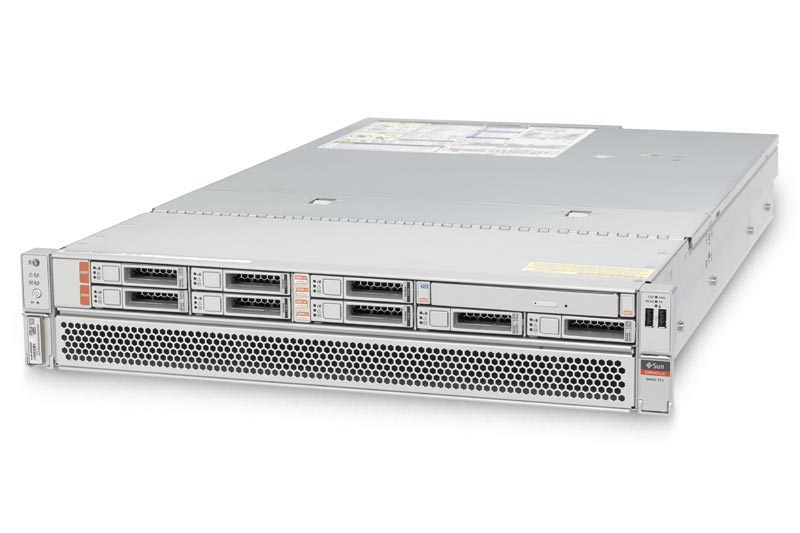

Mettre à jour des Ldoms sur Oracle Solaris 11.3 en 20 minutes !
Oracle Solaris 11 dispose d'un puissant système de mise à jour basé sur IPS et sur ZFS. Quand on met à jour le système d'exploitation un nouvel environnement est créé contenant le système mis à jour. Ce fonctionnement a pour avantage de ne pas avoir d'impact sur l'environnement actuellement actif puisqu'on ne le modifie pas directement.
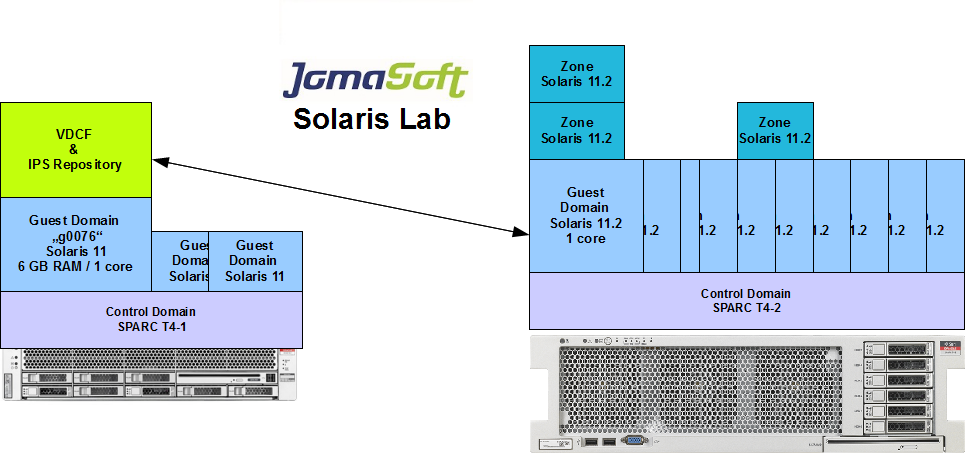

Livre Oracle Solaris 11.2 System Administration Handbook
Il y a peu de livres traitant de Solaris et aujourd'hui d'Oracle Solaris. De plus le système d'exploitation a énormément évolué depuis ces dernières années.
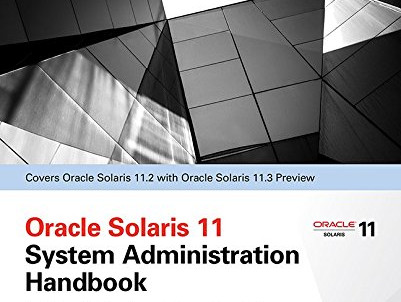

Déployer des agents Oracle Enterprise Manger 12c sur Solaris 11.x
Déployer des agents Enterprise Manger sur Solaris n'est pas une tache difficile, et est similaire au déploiement sur les environnements Linux avec juste quelques changements mineurs.
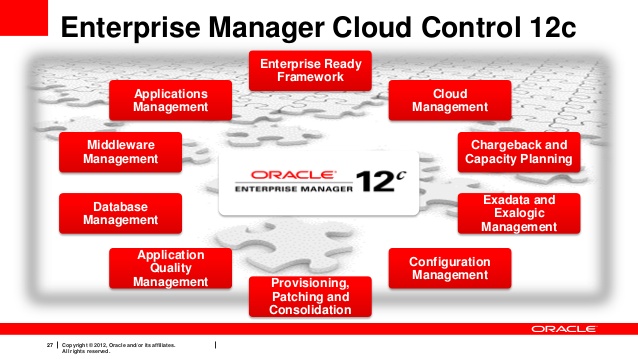

oracle Solaris 11.3 découvrez la vidéo de présentation
Avec l'arrivée de la nouvelle mouture d'Oracle Solaris, Oracle a décidé de vous présenter les nouveaux challenges auquel répond Oracle Solaris 11.3 orienté sur 3 valeurs : La sécurité, la vitesse et la simplicité.
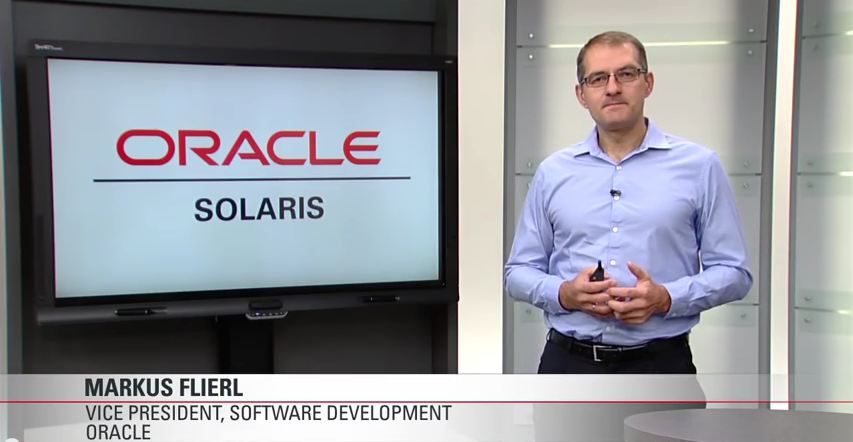

Vue d’ensemble des différentes générations de Sparc
Savez-vous combien il y a de types de CPU SPARC actuellement sur le marché ? Pas un, pas deux, mais cinq. Le SPARC64-VII, le T3, le T4, T5, M5 et M10.


Benchmark entre Oracle et IBM en terme de coût global
Benchmark entre Oracle et IBM en terme de coût global
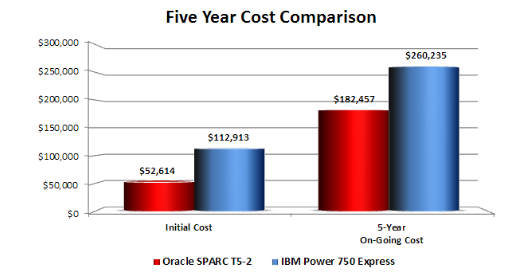

Vidéo de la TechDay 2013 sur Sparc et Solaris
Retrouver le compte rendu vidéo du TechDay Solaris/SPARC qui s'est déroulé le 15 mai à PARIS.


Oracle Solaris Sparc TechDay 2013 : Retour sur l’événement
Oracle-Solaris.fr était présent à cette événement d'envergure pour les technologies Oracle Solaris et Sparc. L'objectif premier était d'y faire des rencontres, entre administrateur et ingénieur système Solaris mais aussi d'y partager ces expériences.
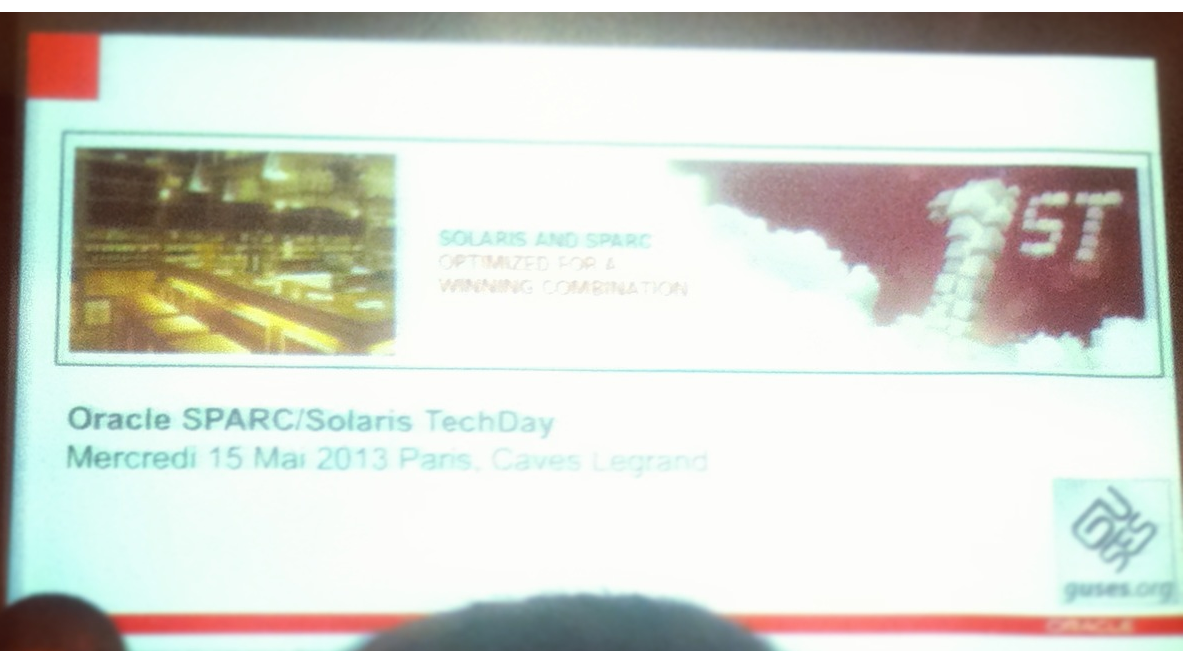

Description
La commande format est une des commandes exclusives à Solaris. Très utile elle permet de manager les disques physiques de manière intuitive et puissante. La commande format permet d’ouvrir un shell interne à l’application un peu comme avec la comme fdisk mais la gestion des formatages et des partitions est beaucoup plus intuitive et ergonomique.
Véritablement indispensable pour les administrateurs systèmes il faut utiliser cette commande lorsque l’on connait bien ce que l’on veut faire car l’erreur arrive assez vite et ne pardonne pas (expérience personnelle…)
Exemple
axel@solaris:~$ format Searching for disks...done
AVAILABLE DISK SELECTIONS: 0. c7t0d0 <ATA -VBOX HARDDISK -1.0 cyl 4093 alt 2 hd 128 sec 32> /pci@0,0/pci8086,2829@d/disk@0,0 Specify disk (enter its number): 0 selecting c7t0d0 [disk formatted] /dev/dsk/c7t0d0s0 is part of active ZFS pool rpool. Please see zpool(1M). /dev/dsk/c7t0d0s2 is part of active ZFS pool rpool. Please see zpool(1M). FORMAT MENU: disk - select a disk type - select (define) a disk type partition - select (define) a partition table current - describe the current disk format - format and analyze the disk fdisk - run the fdisk program repair - repair a defective sector label - write label to the disk analyze - surface analysis defect - defect list management backup - search for backup labels verify - read and display labels save - save new disk/partition definitions inquiry - show vendor, product and revision volname - set 8-character volume name !<cmd> - execute <cmd>, then return quit format> p PARTITION MENU: 0 - change `0' partition 1 - change `1' partition 2 - change `2' partition 3 - change `3' partition 4 - change `4' partition 5 - change `5' partition 6 - change `6' partition 7 - change `7' partition select - select a predefined table modify - modify a predefined partition table name - name the current table print - display the current table label - write partition map and label to the disk !<cmd> - execute <cmd>, then return quit partition> p Current partition table (original): Total disk cylinders available: 4093 + 2 (reserved cylinders) Part Tag Flag Cylinders Size Blocks 0 root wm 1 - 4092 7.99GB (4092/0/0) 16760832 1 unassigned wm 0 0 (0/0/0) 0 2 backup wu 0 - 4092 7.99GB (4093/0/0) 16764928 3 unassigned wm 0 0 (0/0/0) 0 4 unassigned wm 0 0 (0/0/0) 0 5 unassigned wm 0 0 (0/0/0) 0 6 unassigned wm 0 0 (0/0/0) 0 7 unassigned wm 0 0 (0/0/0) 0 8 boot wu 0 - 0 2.00MB (1/0/0) 4096 9 unassigned wm 0 0 (0/0/0) 0
Man Solaris de la commande format
System Administration Commands format(1M) NAME format - disk partitioning and maintenance utility SYNOPSIS format [-f command-file] [-l log-file] [-x data-file] [-d disk-name] [-t disk-type] [-p partition-name] [-s] [-m] [-M] [-e] [disk-list] DESCRIPTION format enables you to format, label, repair, and analyze disks on your system. Unlike previous disk maintenance pro- grams, format runs under SunOS. Because there are limita- tions to what can be done to the system disk while the sys- tem is running, format is also supported within the memory- resident system environment. For most applications, however, running format under SunOS is the more convenient approach. format first uses the disk list defined in data-file if the -x option is used. format then checks for the FORMAT_PATH environment variable, a colon-separated list of filenames and/or directories. In the case of a directory, format searches for a file named format.dat in that directory; a filename should be an absolute pathname, and is used without change. format adds all disk and partition definitions in each specified file to the working set. Multiple identical definitions are silently ignored. If FORMAT_PATH is not set, the path defaults to /etc/format.dat. disk-list is a list of disks in the form c?t?d? or /dev/rdsk/c?t?d?s?. With the latter form, shell wildcard specifications are supported. For example, specifying /dev/rdsk/c2* causes format to work on all drives connected to controller c2 only. If no disk-list is specified, format lists all the disks present in the system that can be admin- istered by format. Removable media devices are listed only when users execute format in expert mode (option -e). This feature is provided for backward compatibility. Use rmformat(1) for rewritable removable media devices. OPTIONS The following options are supported: -d disk-name Specify which disk should be made current upon entry into the program. The disk is specified by its logical name (for instance, -d c0t1d0). This SunOS 5.11 Last change: 25 Sep 2008 1 System Administration Commands format(1M) can also be accomplished by specifying a single disk in the disk list. -e Enable SCSI expert menu. Note this option is not recommended for casual use. -f command-file Take command input from command-file rather than the standard input. The file must contain commands that appear just as they would if they had been entered from the keyboard. With this option, format does not issue continue? prompts; there is no need to specify y(es) or n(o) answers in the command- file. In non-interactive mode, format does not initially expect the input of a disk selection number. The user must specify the current working disk with the -d disk-name option when format is invoked, or specify disk and the disk selection number in the command-file. -l log-file Log a transcript of the format session to the indicated log-file, including the standard input, the standard output and the standard error. -m Enable extended messages. Provides more detailed information in the event of an error. -M Enable extended and diagnostic mes- sages. Provides extensive information on the state of a SCSI device's mode pages, during formatting. -p partition-name Specify the partition table for the disk which is current upon entry into the program. The table is specified by its name as defined in the data file. This option can be used only if a disk is being made current, and its type is either specified or available from the disk label. SunOS 5.11 Last change: 25 Sep 2008 2 System Administration Commands format(1M) -s Silent. Suppress all of the standard output. Error messages are still displayed. This is generally used in conjunction with the -f option. -t disk-type Specify the type of disk which is current upon entry into the program. A disk's type is specified by name in the data file. This option can only be used if a disk is being made current as described above. -x data-file Use the list of disks contained in data-file. USAGE When you invoke format with no options or with the -e, -l, -m, -M, or -s options, the program displays a numbered list of available disks and prompts you to specify a disk by list number. If the machine has more than 10 disks, press SPACE to see the next screenful of disks. You can specify a disk by list number even if the disk is not displayed in the current screenful. For example, if the current screen shows disks 11-20, you can enter 25 to specify the twenty-fifth disk on the list. If you enter a number for a disk that is not currently displayed, format prompts you to verify your selection. If you enter a number from the displayed list, format silently accepts your selec- tion. After you specify a disk, format displays its main menu. This menu enables you to perform the following tasks: analyze Run read, write, compare tests, and data purge. The data purge function implements the National Computer Security Center Guide to Understanding Data Remnance (NCSC-TG-025 version 2) Overwrit- ing Algorithm. See NOTES. backup Search for backup labels. cache Enable, disable, and query the state of the write cache and read cache. This menu item only appears when format is invoked with the -e SunOS 5.11 Last change: 25 Sep 2008 3 System Administration Commands format(1M) option, and is only supported on SCSI devices.. current Display the device name, the disk geometry, and the pathname to the disk device. defect Retrieve and print defect lists. This option is supported only on SCSI devices. IDE disks per- form automatic defect management. Upon using the defect option on an IDE disk, you receive the message: Controller does not support defect management or disk supports automatic defect management. disk Choose the disk that will be used in subsequent operations (known as the current disk.) fdisk Run the fdisk(1M) program to create a fdisk partition for Solaris software (x86 based sys- tems only). format Format and verify the current disk. This option is supported only on SCSI devices. IDE disks are pre-formatted by the manufacturer. Upon using the format option on an IDE disk, you receive the message: Cannot format this drive. Please use your manufacturer-supplied formatting utility. inquiry Display the vendor, product name, and revision level of the current drive. label Write a new label to the current disk. partition Create and modify slices. quit Exit the format menu. SunOS 5.11 Last change: 25 Sep 2008 4 System Administration Commands format(1M) repair Repair a specific block on the disk. save Save new disk and slice information. type Select (define) a disk type. verify Read and display labels. Print information such as the number of cylinders, alternate cylinders, heads, sectors, and the partition table. volname Label the disk with a new eight character volume name. ENVIRONMENT VARIABLES FORMAT_PATH a colon-separated list of filenames and/or directories of disk and partition defini- tions. If a directory is specified, format searches for the file format.dat in that directory. FILES /etc/format.dat default data file ATTRIBUTES See attributes(5) for descriptions of the following attri- butes: ____________________________________________________________ | ATTRIBUTE TYPE | ATTRIBUTE VALUE | |_____________________________|_____________________________| | Availability | SUNWcs | |_____________________________|_____________________________| SEE ALSO fmthard(1M), prtvtoc(1M), rmformat(1), format.dat(4), attri- butes(5), sd(7D) x86 Only fdisk(1M) SunOS 5.11 Last change: 25 Sep 2008 5 System Administration Commands format(1M) WARNINGS When the format function is selected to format the Maxtor 207MB disk, the following message displays: Mode sense page(4) reports rpm value as 0, adjusting it to 3600 This is a drive bug that may also occur with older third party drives. The above message is not an error; the drive will still function correctly. Cylinder 0 contains the partition table (disk label), which can be overwritten if used in a raw disk partition by third party software. format supports writing EFI-compliant disk labels in order to support disks or LUNs with capacities greater than one terabyte. However, care should be exercised since many software components, such as filesystems and volume managers, are still restricted to capacities of one terabyte or less. See the System Administration Guide: Basic Adminis- tration for additional information. By default, on an unlabeled disk, EFI labels will be written on disks larger than 2 TB. When format is invoked with the -e option, on writing the label, the label type can be chosen. Booting is not currently supported on a disk with an EFI label. NOTES format provides a help facility you can use whenever format is expecting input. You can request help about what informa- tion is expected by simply entering a question mark (?) and format prints a brief description of what type of input is needed. If you enter a ? at the menu prompt, a list of available commands is displayed. For SCSI disks, formatting is done with both Primary and Grown defects list by default. However, if only Primary list is extracted in defect menu before formatting, formatting will be done with Primary list only. Changing the state of the caches is only supported on SCSI devices, and not all SCSI devices support changing or saving the state of the caches. SunOS 5.11 Last change: 25 Sep 2008 6 System Administration Commands format(1M) The NCSC-TG-025 algorithm for overwriting meets the DoD 5200.28-M (ADP Security Manual) Eraser Procedures specifica- tion. The NIST Guidelines for Media Sanitization (NIST SP 800-88) also reference this algorithm. SunOS 5.11 Last change: 25 Sep 2008 7
Articles en relation:
Aujourd’hui aura lieu un événement majeur pour Oracle car les nouveaux Netra Sparc T4 vont être présentés sur internet via un webcast.
Voici un résumé de ce que vous verrez dans ce webcast :
Comment pouvons-nous vous aider à créer des services de communication capable de résister aux exigences de millions d’utilisateurs autour de la planète et les déployer de manière rentable?
Rejoignez-nous le 24 Janvier 2012 pour un webinaire gratuit: 5 étapes pour accélérer les performances et la Basse TCO des charges de travail des communications.
Propulsé par le nouveau processeur SPARC T4, ces serveurs traduisent par une amélioration spectaculaire des performances tout en réduisant le TCO grâce à des fonctions intégrées de gestion, de virtualisation, des réseaux et de sécurité.
Dans ce webinar, vous apprendrez à:
- Améliorer les performances des applications jusqu’à 5x grâce à la dynamique de processeur SPARC T4 capacité de filetage
- Déployer des charges de travail dans les environnements échelle de l’entreprise de nuages avec de nouvelles fonctionnalités d’Oracle Solaris 11 telles que la virtualisation améliorée, l’isolement charge de travail et de sécurité améliorées, le tout sans frais supplémentaires
- Livrer une informatique sécurisée à vitesse filaire grâce à l’accélération cryptographique intégré sur puce * Gérez votre environnement avec des outils de gestion intégrés tels que Oracle Ops Center, inclus sans frais
- Utiliser les plates-formes de classe transporteur de confiance du serveur pour les déploiements de plusieurs années
Pour participer (ou revoir le webinar) cliquer ici
Articles en relation:
Actualités by .
Le 20 décembre Oracle a ajouté sur My Oracle Support la nouvelle version d’Oracle Explorer inclus dans STB 6.4.
Pour ceux qui ne connaissent pas encore bien cette outil voici un rapide résumé : Oracle Explorer est un outil introduit initialement par Sun pour diagnostiquer un serveur physique. En effet, l’outil lance des scans de processeurs, ram, disques, etc.. ainsi que la liste des packages installés et leur version et enfin il récupère des logs systèmes. C’est un résumé assez rapide de ce qu’il fait vraiment mais c’est à peu près ça. L’outil génère au final un fichier qui peut être lu par les outils interne d’Oracle. Cela permet aux techniciens en charge des incidents serveurs de faire un diagnostique rapide de l’état du serveur et donc d’identifier plus rapidement la cause du problème.
STB est un ensemble de logiciels systèmes dans lequel on retrouve Oracle Explorer.
Pour en revenir à cette nouvelle version sachez qu’elle apporte un bien meilleur diagnostique sur les équipements suivants :
Sun SPARC Enterprise T1000, T2000, T5120, T5140, T5220, T5240, T5440, T3-1, T3-2, T3-4.
En effet, Oracle encourage fortement d’installer ce logiciel et se munir d’un explorer (fichier généré par l’outil) lors de l’ouverture d’un ticket car cela augmente grandement le temps du diagnostique.
Je vais de ce pas mettre à jour STB et vous ?
Articles en relation:
Actualités by .
Oracle Solaris Cluster 4.0 est la nouvelle version cluster compatible avec Solaris 11. L’installation devient très simple car elle devient intégrée dans IPS. Orienté cloud, OSC 4.0 est spécialement conçu pour faire fonctionner des cluster de logiciels comme Oracle Database ou encore Oracle Weblogic.
- Déploiement d’applications virtualisés dans le cluster
- Détection d’erreur sur les systèmes avec prévention de la disponibilité
- Répartition de charges entre les noeuds du cluster et priorisation des applications
- Intégration complète dans Oracle Enterprise Manager 12c
OSC 4.0 support les zones et les domains (Oracle VM Server for Sparc) afin d’ajouter une couche de protection pour la disponibilité des applications. En effet, il propose des systèmes de récupérations au niveau domaines ou zones via l’ensemble des noeuds du cluster.
En natif OSC 4.0 est compatible avec les logiciels suivants : Apache, Apache Tomcat, DHCP, DNS, NFS en plus des logiciels de la suite Oracle comme : PeopleSoft, Siebel CRM, E-Business Suite
Pour Solaris 10 la dernière version est la version 3.3 5/11.
Lien vers la page de présentation des changements
Télécharger Oracle Cluster 4.0
Articles en relation:
Actualités by .
Avec la sortie récente de Solaris 11 il est bon de faire un point sur les nouveautés apportés à LDoms (ou Oracle VM server for Sparc) grâce à Solaris 11. Nous allons principalement nous intéresser à la partie réseau.
En effet, cette partie réseau a été améliorer notamment avec l’ajout d’une couche supplémentaire appelé Crossbow. En gros il s’ajout de virtualisation de cartes réseaux.
 La pile réseau a été considérablement changé grâce au projet Crossbow notamment au niveau de son architecture. Comme on peut le voir sur l’image précédente Crossbow est utilisé pour virtualiser les cartes NIC (réseau). Par exemple la fonction VNIC permet de diviser une carte NIC en plusieurs interfaces virtuelles pour fournir une pile réseau indépendante pour les applications.
La pile réseau a été considérablement changé grâce au projet Crossbow notamment au niveau de son architecture. Comme on peut le voir sur l’image précédente Crossbow est utilisé pour virtualiser les cartes NIC (réseau). Par exemple la fonction VNIC permet de diviser une carte NIC en plusieurs interfaces virtuelles pour fournir une pile réseau indépendante pour les applications.
Ainsi la partie réseau de Logical Domain a été re-structuré avec l’architecture Crossbow afin d’utiliser au mieux les améliorations proposés par Crossbow. Le commutateur de Logical Domain est maintenant conçu pour être disposé au dessus de la couche mac de Crossbow. Ainsi les hôtes guest sont totalement indépendant et il faut utiliser VSW pour que les hôtes puisse communiquer entre eux.
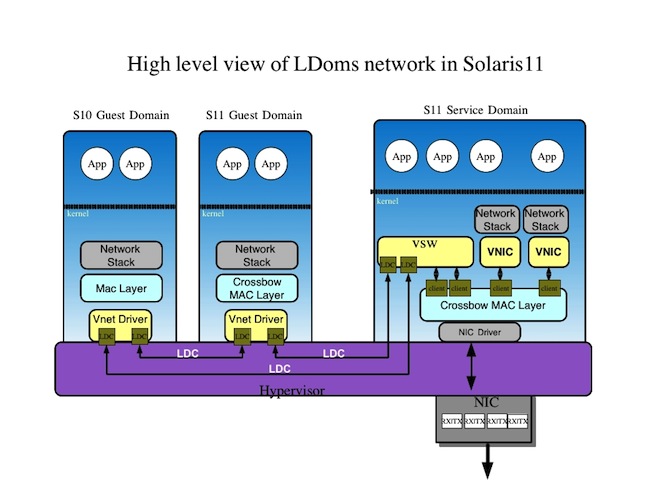 Toutes les fonctionnalités existantes avec Solaris 10 sont compatible sur Solaris 11. Voici un résumé des fonctionnalités avec Solaris 11 :
Toutes les fonctionnalités existantes avec Solaris 10 sont compatible sur Solaris 11. Voici un résumé des fonctionnalités avec Solaris 11 :
- VLAN
- détection d’erreur sur les cartes virtuelles
- Aggrégation de lien
Solaris11 introduit également un mécanisme de détection de panne IPMP.
Articles en relation:
Actualités by .

